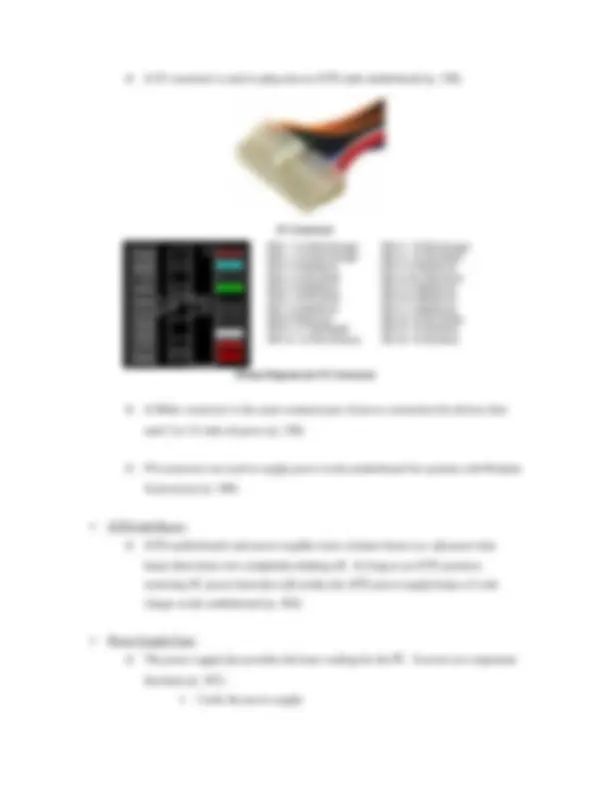





Study with the several resources on Docsity

Earn points by helping other students or get them with a premium plan


Prepare for your exams
Study with the several resources on Docsity

Earn points to download
Earn points by helping other students or get them with a premium plan
Community
Ask the community for help and clear up your study doubts
Discover the best universities in your country according to Docsity users
Free resources
Download our free guides on studying techniques, anxiety management strategies, and thesis advice from Docsity tutors
An in-depth exploration of computer cases and power supplies, discussing their sizes, drive bays, and various connectors. Learn about full-tower, mid-tower, mini-tower, and desktop cases, as well as external and internal drive bays, and the importance of power connectors for different motherboard types. Gain insights into power supplies, their wattage, and the role of fans in cooling and airflow.
Typology: Exams
1 / 6

This page cannot be seen from the preview
Don't miss anything!




Power Supplies and Cases September 26 (Day); September 27 (Night) A computer case is the first thing you notice when you see a computer. Made of metal (or sometimes plastic), it’s the box that houses all of the components and devices that make up a computer (p. 149). External Size: o The size of the case should depend on several factors (p. 149): Do you plan to upgrade the system at a later date? Who will be using the system? What will be the final location of the system? Case Sizes:
Lots of interior space to add a variety of drives and expansion cards: Normally have at least four external drive bays (for CD-ROMs, CD-RW drives, DVD drives, etc.) Normally have at least two external floppy disk drive bays. Normally have between 3-5 internal drive bays (for hard drives) Usually placed on the floor
atop a desk. Usually at least twenty inches tall. Normally have three external drive bays, one external floppy drive bays, and 1 or 2 internal drive bays. o Mini-tower case (p. 150):
tower case.
Normally have two external drive bays, one external floppy drive bay, and one internal drive bay. o Desktop case (p. 150): A desktop case lies flat on its larger size. Designed to sit on your desk with a monitor resting on top of them. Full Tower Case Mid Tower Case Mini Tower Case Desktop Case Drive Bays:
o Like cases, power supplies are built for motherboard form factors (p. 156). o Power supplies share a number of features (p. 156):
throughout the case. Power Connectors: o Power connectors deliver power to the parts of the computer that need power (p. 158). o All power connectors have some sort of safety feature that prevents them from being plugged in improperly (p. 158).
P8/P9 Connector P8 Connector PIN 1 P.G. (Orange) PIN 2 +5VDC (Red) PIN 3 +12VDC (Yellow) PIN 4 - 12VDC (Blue) PIN 5 GND ( Black ) PIN 6 GND ( Black ) P9 Connector PIN 1 P.G. (Orange) PIN 2 +5VDC (Red) PIN 3 +12VDC (Yellow) PIN 4 - 12VDC (Blue) PIN 5 GND ( Black ) PIN 6 GND ( Black ) Pinout Diagram for P8/P9 Connector
P1 Connector PIN 1 +3.3VDC(Orange) PIN 2 +3.3VDC(Orange) PIN 3 COM(Black) PIN 4 +5VDC(Red) PIN 5 COM(Black) PIN 6 +5VDC(Red) PIN 7 COM(Black) PIN 8 POK(Gray) PIN 9 +5 VSB(Purple) PIN 10 +12VDC(Yellow) PIN 11 +3VDC(Orange) PIN 12 -12VDC(Blue) PIN 13 COM(Black) PIN 14 PS-ON(Green) PIN 15 COM(Black) PIN 16 COM(Black) PIN 17 COM(Black) PIN 18 -5VDC(White) PIN 19 +5VDC(Red) PIN 20 +5VDC(Red) Pinout Diagram for P1 Connector
need 5 or 12 volts of power (p. 159).
4 processors (p. 160). ATX Soft Power:
keeps them from ever completely shutting off. As long as an ATX system is receiving AC power from the wall socket, the ATX power supply keeps a 5-volt charge on the motherboard (p. 162). Power Supply Fans:
functions (p. 167): Cools the power supply